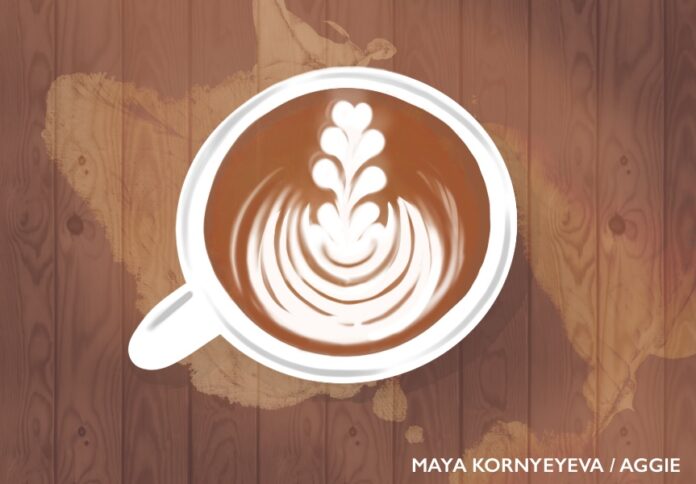Latte art as the mark of excellent coffee craft
By MAYA KORNYEYEVA — mkornyeyeva@ucdavis.edu
You walk into your local coffee shop and order a hot latte, noting that the line isn’t long and the atmosphere in the cafe is relaxed and uplifting. You pay for your drink, stand to the side to make way for the next customer and patiently wait for your name to be called out.
Once your order is up on the bar and ready for pick up — even if it took slightly longer than expected or you have grown cranky from your caffeine withdrawal — the sight of the beautifully rich espresso adorned with an intricate pattern of white foam makes your heart sparkle and your soul do a happy skip. It’s not just that the latte looks visually stunning; latte art is a telling sign of a well-crafted beverage — coffee honed to perfection.
The term “latte art” was coined by David Schomer in 1992 (alongside the infamously tricky yet successful pattern of the “rosetta”), and emerged into the commercial world at the turn of the 21st century. Latte art traces its roots back all the way to the first instance of milk being added to coffee in Austria (1697), where this revolutionary combination of ingredients became the predecessor of a whole new type of coffee beverage.
Latte art is a technique that can only be achieved if a barista creates a perfect, unexpired shot of espresso — with a fine layer of crema on top — and steams their milk correctly. To produce that perfect ‘microfoam,’ the milk needs to be steamed so that it increases in volume by around 33%. This expansion of the milk is a result of tiny bubbles, which are dispersed throughout the milk during the steaming process and give it that characteristically sweet and smooth texture.
Without having a balanced shot of espresso and milk with microfoam, latte art is extremely difficult to achieve. For instance, espresso shots that have been sitting out on the counter for over 30 seconds begin to “expire” and lose their crema layer, which is the crucial canvas for a latte art design. If the milk is aerated too much it becomes overly bubbly and foamy, and if it is aerated too little then there’s not enough microfoam: both very difficult conditions to work with.
As latte art was originally a staple of the specialty coffee scene, being able to create a cup with a beautiful design is the sign of skilled craftsmanship, and beyond that, it is the mark of high quality coffee. The process of measuring out your coffee grinds, tamping and distributing the coffee and brewing with the correct ratio of water and pressure are all variables that require mathematical precision. If a barista doesn’t perform these steps correctly, a shot of espresso could be nearly impossible to adorn with latte art — even if the actual coffee used was of a high caliber. Same with the milk; an improper positioning of the steam wand, a mistake in the temperature or initial aeration can create irreparable damage to the quality of the final beverage.
Whenever I visit a coffee shop, I leave with a much higher appreciation for the cafe if the baristas are able to create latte art designs and pour coffee at such a high standard. The countless design possibilities, such as a rosetta, tulip, heart, fishtail, leaf, swan and many others, are all attainable through continuous, diligent practice. Nobody is perfect at latte art from the first time they touch a pitcher of steamed milk and a cup of espresso. Over time, muscle memory and guidance from a trainer help build the foundation for consistently impressive art.
Next time you visit a cafe that serves drinks with latte art, I encourage you to give an extra thanks or a thumbs up to the management and the barista. Not only did they take the time and effort to train this creative skill, but it also means that you got a great cup of coffee; with excellent craft, flavor and technique.
Written by: Maya Kornyeyeva — mkornyeyeva@ucdavis.edu
Disclaimer: The views and opinions expressed by individual columnists belong to the columnists alone and do not necessarily indicate the views and opinions held by The California Aggie.





